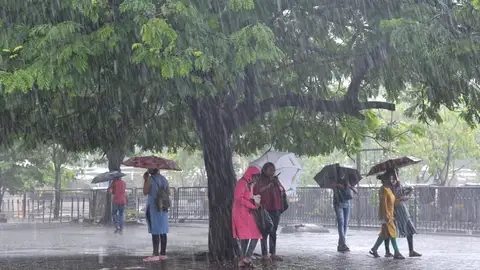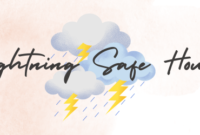Preparations for the Rainy Season and Storms – The rainy season, often accompanied by storms, can bring both relief and challenges. While the rain nourishes the earth, it can also cause floods, power outages, and dangerous conditions.
To ensure safety and preparedness, it is important to take proactive steps. Here are 20 things you should prepare for the rainy season and storms.
1. Check Roof and Gutters
Your roof is the first line of defense against heavy rain. Ensure that there are no leaks, cracks, or loose shingles. Clean out gutters and downspouts to prevent water from pooling and causing structural damage or flooding.
2. Secure Windows and Doors
Ensure windows and doors are sealed properly to keep rainwater out. Installing storm shutters or reinforcing windows with storm-proof glass is also recommended for areas prone to strong winds.
Read also:
1. How to Prepare for a Heatwave Disaster
2. Emergency Basement & Food Supply Ideas, Anti-Disasters
3. Building a Tornado-Resistant Home: Key Strategies for Safety and Durability
3. Trim Trees and Secure Yard Items
Heavy winds can knock down tree branches, causing damage to your home or nearby power lines. Trim overhanging branches and secure loose yard items like garden furniture, toys, or equipment to prevent them from becoming dangerous projectiles during storms.
4. Prepare an Emergency Kit
An emergency kit is crucial during the rainy season and storms. This should include:
- Non-perishable food and water (enough for 3 days)
- First-aid supplies
- Flashlights and extra batteries
- Emergency blankets
- A portable phone charger
- A battery-powered or hand-crank radio
5. Install Surge Protectors
Power surges caused by lightning or electrical storms can damage your appliances. Installing surge protectors can prevent costly damage to your home’s electrical devices.
6. Inspect Drainage Systems
Check your home’s drainage systems to ensure water can flow away easily from your property. Blocked drains or poor drainage can lead to water accumulation and flooding.
7. Waterproof Important Documents
Keep important documents, like passports, insurance papers, and property deeds, in waterproof containers or bags. Alternatively, digitize them and store them securely online to ensure you have access to them in case of flooding.
8. Stock Up on Sandbags
If your area is prone to flooding, stock up on sandbags ahead of time. Placing sandbags around your property can help divert water and prevent it from entering your home.
9. Inspect Your Vehicle
Make sure your car is in good working condition. Check tire tread and windshield wipers, and ensure your brakes are responsive. A well-maintained vehicle is essential in case you need to evacuate or travel during heavy rains.
10. Backup Power Supply
Power outages are common during storms. Invest in a backup generator or battery power station to keep essential appliances like refrigerators, sump pumps, or medical devices running during blackouts.
11. Prepare for Communication Disruptions
Cell towers and internet connections may be disrupted during storms. Make sure to have a battery-operated or hand-crank radio to receive weather updates and emergency information. Consider using walkie-talkies or two-way radios as a backup communication tool.
12. Know Evacuation Routes
Familiarize yourself with local evacuation routes and emergency shelters. This is especially important if you live in areas prone to severe flooding or landslides.
13. Create a Family Emergency Plan
Ensure that your family has a clear plan in place for what to do in the event of a storm. Designate meeting points, emergency contacts, and procedures for evacuating or sheltering in place. Make sure everyone knows how to turn off utilities, such as gas, water, and electricity.
14. Reinforce Your Home
For those living in hurricane-prone areas, reinforcing doors, installing hurricane straps, and securing the foundation of your home can add an extra layer of protection. Consider upgrading to storm-resistant materials if possible.
15. Prepare for Flooding
If you live in a flood-prone area, it is important to elevate appliances and utilities such as water heaters, air conditioners, and electrical outlets. Also, check your insurance policy to ensure that flood damage is covered.
16. Install a Sump Pump
A sump pump helps to remove water from the basement or lower levels of your home. If you don’t already have one, installing a sump pump can prevent water damage during heavy rains. Ensure the pump is working correctly and has a backup power source.
17. Store Extra Fuel
If you rely on fuel-powered appliances, such as generators, ensure you have a supply of extra fuel stored safely. During a storm, fuel supplies may be limited, and gas stations may be inaccessible.
18. Inspect and Repair Sewage Systems
Sewage backups can occur during heavy rainfall, leading to dangerous health hazards. Ensure your septic tank and sewage systems are in good condition before the rainy season begins.
19. Check and Update Insurance Policies
Review your home, health, and vehicle insurance policies to ensure they cover storm and flood-related damages. Some policies may not include flood insurance, so it is important to update them if needed.
20. Monitor Weather Reports Regularly
Staying informed is key during the rainy season. Monitor weather forecasts and warnings from reliable sources like local news, government weather agencies, or meteorological apps. Early warning can give you more time to prepare or evacuate if necessary.
Conclusion
Preparation is crucial for facing the challenges of the rainy season and storms. By securing your home, having an emergency plan, and keeping essential supplies ready, you can minimize the risks and ensure the safety of your family. These proactive steps not only protect your property but also give you peace of mind knowing you’re ready for whatever the weather brings.






